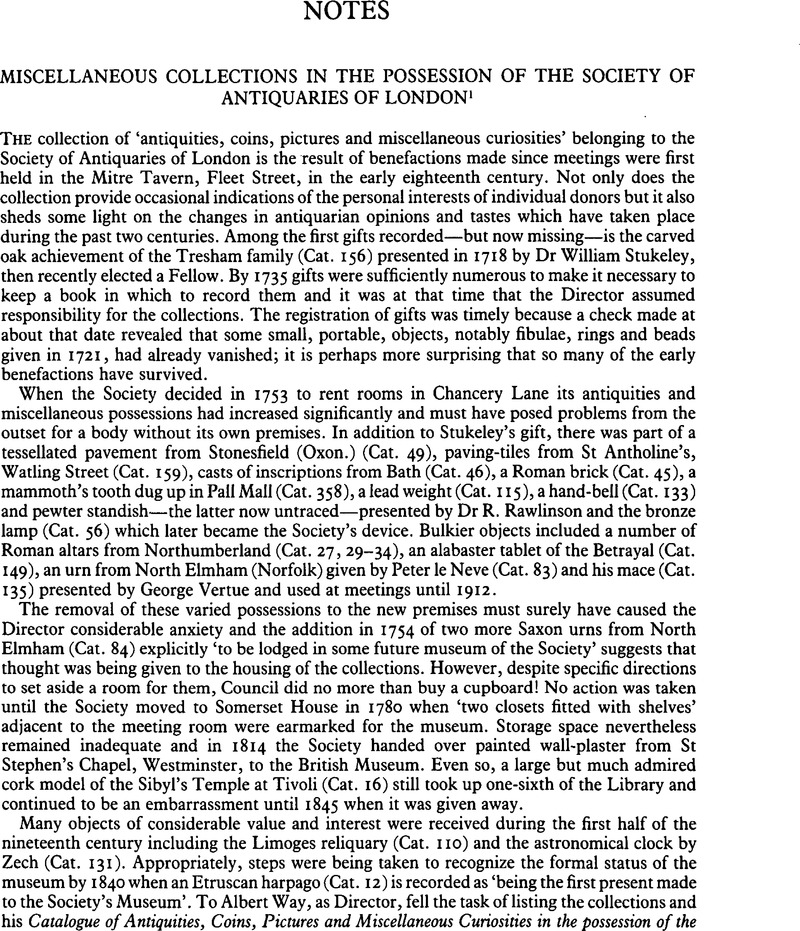Published online by Cambridge University Press: 21 April 2011

2 I am indebted to Mr B. F. Cook, Keeper of the Department of Greek and Roman Antiquities in the British Museum, for drawing my attention to this slab and helping with the present article: and to Miss Susan Bird for redrawing the two sides of the slab.
3 British Museum, register no. 1805.7-3.31; Smith, A. H. (ed.), A Catalogue of Sculpture in the Department of Greek and Roman Antiquities, British Museum, 3 vols. (London, 1892-1904), in (7), 58–9, no. 1657Google Scholar.
4 Ibid., in, 59.
5 These must be distinguished from the use of fingers (digiti) to denote, by their number and positioning, specific numerals, as in ps.Bede, De temporum ratione, i, section headed De compute vel loquela digitorum; cf. Rieche, Anita, ‘Computatio Romana. Fingerzahlen auf provinzialromischen Reliefs’, Bonner Jahrbiicher, clxxxvi (1986), 165-92.Google Scholar
6 Hultsch, F., Griechische und römische Metrologie (2nd edn., Berlin, 1882), 28–9, 74Google Scholar; Dilke, O. A. W., Mathematics and Measurement (London, 1987), 23–8.Google Scholar For measures taken from the human body see Vitruvius, iii. 1.5.
7 Hultsch, , op. cit. (note 6), 386–90;Google ScholarSegrè, Angelo, Metrologia e circolazione monetaria degli antichi (Bologna, 1928), 115Google Scholar.
8 Hultsch, , op. cit. (note 6), 475.Google Scholar
9 Hultsch, , op. cit. (note 6), 28–9;Google ScholarRobertson, D. S., A Handbook of Greek and Roman Architecture (2nd rev. edn., Cambridge, 1945), index s.v. FootGoogle Scholar.
10 Also called ‘royal’, or ‘Philetairic’ as connected with the Attalid dynasty of Pergamon.
11 See , Pauly-Wissowa, Real-Encyclopädie der classischen Altertumswissenschaft, 2nd ser. xvii (Stuttgart, 1961), cols. 604–65,Google Scholar s.v. uncia; Enciclopedia Italiana s.v. metrici, sistemi.
12 For the pes Drusianus, see Duncan-Jones, R. P., ‘Length-units in Roman town-planning: the pes monetalis and the pes Drusianus’, Britannia, xi (1980), 127–33;CrossRefGoogle Scholar M. Millett, ‘Distinguishing between the pes monetalis and the pes Drusianus: some problems’, ibid., xiii (1982), 315-20; Dilke, O. A. W., ‘Ground survey and measurement in Roman towns’, in Grew, F. and Hobley, B. (eds.), Roman Urban Topography in Britain and the Western Empire, Counc. Brit. Arch. Res. Rep. 59 (London, 1985), 6–13. See also n. 23 belowGoogle Scholar.
13 For masons' marks on Roman buildings see Lugli, G., La tecnica edilizia romana (Rome, 1957), I, 201–5.Google Scholar Many of these are adapted from the Greek alphabet
14 Hultsch, , op. cit. (note 6), 526, 671.Google Scholar
15 Frontinus, , De aquae ductu Urbis Romae, 24.Google Scholar
16 Giacchero, Marta (ed.), Edictum Diocletiani el collegarum de pretiis rerum venalium (Genoa, 1974), I.170.Google Scholar
17 Ibid., 1.158.
18 Ibid., 1.160-2.
19 Diogenes Laertius, i. 103 (four daktyloi); Dio Chrysostom, Or. 64.10 (three daktyloi).
20 Juvenal, 12.58, cf. 14.289; Courtney, E., A Commentary on the Satires of Juvenal (London, 1980), 524,Google Scholar on 12.57-9.
21 Haselberger, L., ‘Werkzeichnungen am jüngeren Didymeion’, Mitteilungen des Deutschen Arch. Inst., Abt. Istanbul, xxx (1980), 191–215;Google Scholarid., ‘The construction plans for the temple of Apollo at Didyma’, Scientific American (Dec. 1985), 126-32.